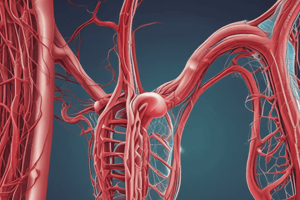Podcast
Questions and Answers
What is the significance of understanding pathophysiology in healthcare?
What is the significance of understanding pathophysiology in healthcare?
It helps in understanding disease mechanisms and their effects on bodily functions.
The study of the changes in normal physiological processes due to disease is known as ______.
The study of the changes in normal physiological processes due to disease is known as ______.
pathophysiology
Match the following terms with their correct definitions:
Match the following terms with their correct definitions:
Applied Anatomy = Study of body structures related to clinical practices Physiology = Study of normal body functions Pathophysiology = Study of changes in bodily functions due to disease Anatomy = Study of body structures and their relationships
Flashcards
Medical Chart
Medical Chart
A document used to record patient medical history and treatment.
Anatomy Diagram
Anatomy Diagram
A visual representation of the body's structure.
Computer Screen
Computer Screen
A display device that shows information from a computer.
Patient Data
Patient Data
Signup and view all the flashcards
Medical Documentation
Medical Documentation
Signup and view all the flashcards
Medical Diagram
Medical Diagram
Signup and view all the flashcards
Patient Chart
Patient Chart
Signup and view all the flashcards
Medical Records
Medical Records
Signup and view all the flashcards
Anatomy
Anatomy
Signup and view all the flashcards
Physiology
Physiology
Signup and view all the flashcards
Study Notes
Applied Anatomy, Physiology & Pathophysiology Exam Guidance
-
Learning Outcomes: Learners will understand human anatomy and physiology, and how diseases/disorders impact the body.
-
Assessment Criteria (1): Identify human body structure, describe its functions, explain special sense physiology. Specific systems to include: gastrointestinal, nervous, ear, nose, throat, endocrine, musculoskeletal, reproductive, urinary, lymphatic, skin, hair, and nails. Also, include physiology of hearing, sight, smell, taste, and balance.
-
Assessment Criteria (2): Assess, diagnose, determine patient condition severity, and assist with illness/injury management. This includes patient assessment elements (ABCDE), history taking, physical examination, and clinical observations.
-
Assessment Criteria (2): Example observations:
- Respiratory rate
- Pulse rate
- Blood pressure (manual and automated)
- Blood glucose
- Temperature
- Oxygen saturation
- Capillary refill
- ECG and capnography
- ACVPU (Alert, Confused, Verbal, Pain, Unresponsive) and Glasgow Coma Score (GCS)
- Pupillary reaction
- Normal ranges for adults, children, and infants
- Factors affecting measurements (situation, environment, medication, pre-existing conditions)
- Importance of continuous monitoring and reassessment.
-
Assessment Criteria (2): Related Medical Conditions to include: cardiovascular (heart failure, hypertension), cerebrovascular (stroke, cerebral infarction), musculoskeletal (osteoarthritis, osteoporosis, rheumatoid arthritis), kidney (acute pyelonephritis, acute kidney injury), urinary (obstruction, infection, incontinence), neurological (dementia, Parkinson's), spinal cord/peripheral nerve diseases, developmental nervous system abnormalities, eye disorders, ear disorders, reproductive system diseases.
-
Assessment Criteria (3): Recognize and manage life-threatening infections.
-
Assessment Criteria (3): Includes clinical findings of meningitis in adults and children, management of meningitis, professional definition of sepsis, definition of septic shock.
-
Sepsis Pathophysiology: Sepsis originates from localized infections (skin, lungs, urinary tract), becoming systemic, spreading via bloodstream, causing inflammatory response, leading to tissue damage and organ failure.
-
Sepsis Recognition & Management: Identify sepsis using tools like NEWS2 (National Early Warning Score). Red & yellow flag criteria, risk factors, signs of infection. Recognize if a patient is "sick" and confirm the diagnosis of sepsis. Indications, treatment/management steps and referral.
Studying That Suits You
Use AI to generate personalized quizzes and flashcards to suit your learning preferences.



